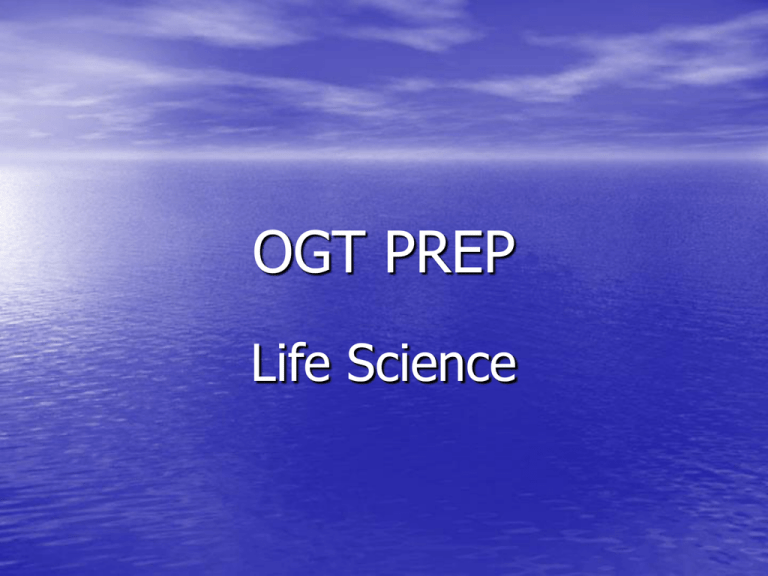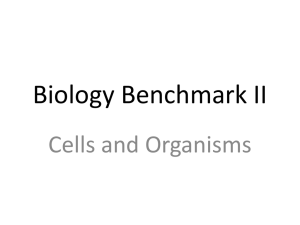
OGT PREP
Life Science
Benchmark A for
Life Science
• Explain that cells are the basic unit of
structure and function of living organisms,
that once life originated all cells come
from pre-existing cells, and that there are
a variety of cell types.
Indicators
for Benchmark A
1. Explain that living cells
a. are composed of a small number of key chemical
elements (carbon, hydrogen, oxygen, nitrogen,
phosphorus and sulfur)
b. are the basic unit of structure and function of all living
things
c. come from pre-existing cells after life originated, and
d. are different from viruses
2. Compare the structure, function and interrelatedness of cell
organelles in eukaryotic cells (e.g., nucleus, chromosome,
mitochondria, cell membrane, cell wall, chloroplast, cilia, flagella)
and prokaryotic cells.
Cell Theory
• Indicator 1, Benchmark A
Sample Question
• The cell theory is important to biology as
the atomic theory is to chemistry. It was
originally proposed in 1838 by Schleiden
and Schwanand has developed through
the years by many scientists through
refinement by observation.
Sample Question
• Which of the following is not one of the
modern tenets of the cell theory?
a. the cell is the structural and functional
unit of all living things.
b. all cells come from pre-existing cells.
c. all energy flow of life occurs within
cells.
d. all cells contain the same organelles.
Sample Question
• The correct answer is D. all cells contain
the same organelles.
• Remember, not all cells contain the same
organelles. Some cells are specialized, for
example the blood cells do not have a
nucleus.
Structure
• Indicator 2, Benchmark A
Sample Question
• A basic organizing definition of life is the type of
cells which compose the organism. The two
main types of cells are the eukaryotic and
prokaryotic cells. What is the essential
difference between them?
a. One has ribosome's and the other does not.
b. One has a nucleus and the other does not.
c. One carries out photosynthesis and the other
does not.
d. One has a cell wall and the other does not.
Sample Question
• The correct answer is B. One has a
nucleus and the other does not.
• Remember, whether or not the cell
contains a nucleus is the essential
difference between the two types of cell.
Benchmark B for
Life Science
• Explain the characteristics of life as
indicated by cellular processes and
describe the process of cell division and
development.
Indicators
for Benchmark B
3. Explain the characteristics of life as indicated by cellular
processes including
a. homeostasis
b. energy transfers and transformation
c. transportation of molecules
d. disposal of wastes
e. synthesis of new molecules
4. Summarize the general processes of cell division and
differentiation, and explain why specialized cells are
useful to organisms and explain that complex
multicellular organisms are formed as highly organized
arrangements of differentiated cells.
Characteristics of Life
• Indicator 3, Benchmark B
Sample Questions
• An essential distinction made in biology is
the difference between living and nonliving things as they are generally
accepted in biological sciences.
• Extended Response (4 points)
Sample Questions
• This answer must contain most of the
characteristics of life.
–
–
–
–
–
–
–
Composed of Cells
Carry out Metabolism
Maintain Homeostasis
Grow
React of Stimuli
Reproduce
Evolve
Cell Division
• Indicator 4 (part), benchmark B
Sample Question
• The cell cycle describes the reproduction of cells. The
process of mitotic cell division as shown in the drawing
below generally occurs in which order?
a. Metaphase, Telophase, Interphase, Prophase,
Cytokinesis, Anaphase, Metaphase
b. Interphase, Telophase, metaphase, anaphase,
interphase
c. prophase, interphase, metaphase, telophase,
cytokinesis
d. interphase, prophase, metaphase, anaphase,
telophase, cytokinesis, interphase
Sample Question
• The correct answer is D. Interphase,
Prophase, Metaphase, Anaphase,
Telophase, Cytokinesis, Interphase
• Remember, during cell division you will
always start and end with Interphase,
which is the time between cell division.
Differentiation
• Indicator 4 (part), benchmark B
Sample Question
• The great variety of organisms is possible
due to_________.
a. cell differentiation
b. cell specialization
c. Mitosis
d. None of the above
Sample Question
• The correct answer is B. Cell
specialization.
• Remember, cell specialization enables
multicellular organisms to adapt and
survive in a variety of environments.
Benchmark C for
Life Science
• Explain the genetic mechanisms and
molecular basis of inheritance.
Indicators
for Benchmark C
5. Illustrate the relationship of the structure and
function of DNA to protein synthesis and the
characteristics of an organism.
6. Explain that a unit of hereditary information is
called a gene, and genes may occur in different
forms called alleles (e.g., gene for pea plant
height has two alleles, tall and short).
Indicators
for Benchmark C
7. Describe that spontaneous changes in DNA are
mutations, which are a source of genetic variation. When
mutations occur in sex cells, they may be passed on to
future generations; mutations that occur in body cells
may affect the functioning of that cell or the organism in
which that cell is found.
8. Use the concepts of Mendelian and non-Mendelian
genetics (e.g., segregation, independent assortment,
dominant and recessive traits, sex-linked traits and
jumping genes) to explain inheritance.
Protein Synthesis
• Indicator 5, Benchmark C
Sample Question
• The genetic code inside the nucleus of a cell is
important in cell reproduction and the
production of proteins by the cell. Protein
synthesis occurs outside the nucleus at the
ribosome's. How does the genetic code for a
protein get from the nucleus to the ribosome?
• Short Answer (2 points)
Sample Question
• mRNA codes the DNA strand inside the
nucleus and then travels out to the
cytoplasm to the ribosome. The mRNA
carries the code for individual proteins.
• Example, GCU codes for alanine
Genes
• Indicator 6, Benchmark C
Sample Question
• The basic unit of inheritance is held in the
sequence of base pairs in a DNA molecule
in a cell. A unit of information in this
system is called___________.
a. DNA
b. a chromosome
c. an allele
d. a gene
Sample Question
• The correct answer is D. gene.
• Remember, the gene is the basic unit of
heredity and can exist in one of several
alleles. Base pairs form the 3 letter
“words” which are used to code for
specific proteins.
Mutations
• Indicator 7, benchmark C
Sample Question
• The environment has an impact on the inheritance of
•
•
•
characteristics from parent to offspring. Three students
made statements in a class debate about this topic:
Student A: Poisonous chemicals can cause mutations in
genetic structure and these frequently cause
evolutionary changes in species.
Student B: Radiation from the sun and other
extraterrestrial sources can cause mutations in skin cells
which can be passed on to their offspring.
Student C: Mutations can occur from many sources but
they are usually repaired by the cell or result in fatal
problems with the offspring.
Sample Question
• Who has correctly stated the situation?
a. Student A only
b. Student B only
c. Student C only
d. Students A and C
Sample Question
• The correct answer is C. Student C.
• Remember, most mutations are usually
repaired or are lethal. Mutations can only
be passed on to offspring if they are in the
sex cells.
Genetics
• Indicator 8, benchmark C
Sample Question
• A male and female pea plant are crossed.
The phenotypes of the offspring are 75%
tall plants and 25% short. Draw a Punnett
Square that demonstrates the genotypes
of the parents and the offspring.
• Short Answer (2 points)
Sample Question
• Be careful and make sure that you answer
the question being asked.
• They want you to draw a punnett square
of the parental generation by using the
known phenotypes of the offspring given
in the question.
• So your genotypes will be TT, Tt, and tt
Sample Questions
• So the only way you
could end up with
75% of the plants tall
and 25% of the
plants short, is if both
parents were
heterozygous tall (Tt).
t
T
T TT
Tt
Tt
tt
t
Benchmark D for
Life Science
• Explain the flow of energy and the cycling
of matter through biological and ecological
systems (cellular, organismal and
ecological).
Indicators
for Benchmark D
9. Describe how matter cycles and energy flows
through different levels of organization in living
systems and between living systems and the
physical environment. Explain how some energy
is stored and much is dissipated into the
environment as thermal energy (e.g., food webs
and energy pyramids).
Indicators
for Benchmark D
10. Describe how cells and organisms acquire and
release energy (photosynthesis, chemosynthesis,
cellular respiration and fermentation).
11. Explain that living organisms use matter and
energy to synthesize a variety of organic
molecules (e.g., proteins, carbohydrates, lipids
and nucleic acids) and to drive life processes
(e.g., growth, reacting to the environment,
reproduction and movement).
Ecosystem Cycles
• Indicator 9, benchmark D
Sample Questions
• The movement of molecules (energy)
through a food web is a cycle. When is
the cycle complete. Describe what
happens once the cycle is complete.
• Short Answer (2 points)
Sample Questions
• First the answer must state that a cycle
is completed when decomposers of the
cycle return the molecules back to the
environment.
• Second, once the molecules are returned
to the environment they can be used
again by producers, which begins a new
cycle.
Acquirement and Release
of Energy
• Indicator 10, benchmark D
Sample Questions
• It can be said that humans and animals
are solar powered. How can this
statement be justified?
• Short Answer (2 points)
Sample Question
• The answer must state something about
how the energy that animals use is stored
in the foods they eat as sugars. These
sugars are produced by plants during
photosynthesis which is powered by the
sun. Animals release the energy through
the process of cellular respiration.
Synthesis
• Indicator 11, benchmark D
Sample Questions
• In order to make a copy of itself, in the process
of mitosis, a cell must use raw materials and
energy found in the cell and synthesize many
different kinds of biological molecules. These
synthesis processes require energy that is found
stored in the cell as________.
a. ATP
b. chlorophyll
c. proteins
d. sugars
Sample Questions
• The correct answer is A. ATP
• Remember, ATP, or Adenosine Tri
Phosphate, is the ENERGY molecule,
which is made by the MITOCHONDRIA of
the cell.
Benchmark E for
Life Science
• Explain how evolutionary relationships
contribute to an understanding of the
unity and diversity of life.
Indicators
for Benchmark E
12. Describe that biological classification
represents how organisms are related with
species being the most fundamental unit of the
classification system. Relate how biologists
arrange organisms into a hierarchy of groups
and subgroups based on similarities and
differences that reflect their evolutionary
relationships.
Indicators
for Benchmark E
13. Explain that the variation of organisms within a
species increases the likelihood that at least
some members of a species will survive under
gradually changing environmental conditions.
14. Relate diversity and adaptation to structures
and their functions in living organisms (e.g.,
adaptive radiation).
Classification
• Indicator 12, benchmark E
Sample Question
• According to biologist Ernst Mayr in 1996,
“Species are groups of interbreeding
natural populations that are reproductively
isolated from other such groups”. The
arrangement of these groups for our
understanding is known as taxonomy. It
helps us describe the interrelatedness of
different species.
Sample Question
• In this process, which of the following would be
most useful?
a. watching the feeding habits of similar
organisms.
b. studying the skeletal structure of different
organisms
c. studying the environments in which different
organisms are found
d. performing a DNA analysis of different
organisms
Sample Question
• The correct answer is D. Performing a
DNA analysis of different organisms.
• Remember, modern taxonomy constructs
cladograms, which are ancestry diagrams,
based on similarities in the genetic make
up.
Diversity
• Indicator 13, benchmark E
Sample Question
• Life on Earth is difficult since the
environment is constantly changing. In
order to survive, organisms have evolved
adaptations which increase the likelihood
that at least some of the population will
survive under changing environmental
conditions.
Sample Question
• Which of the following represents this kind of
adaptation?
a. keeping vestigial appendages which may
some day be useful.
b. sexual reproduction, which provides for
variation within the population.
c. the ability to quickly clone the entire
population to make more individuals
d. strength and mobility to quickly leave an area
that is environmentally challenging.
Sample Question
• The correct answer is B. Sexual reproduction,
which provides for variation within the
population.
• Remember, Sexual reproduction provides a
varied population in which at least a few
members of the population are likely to survive
because of characteristics they possess that are
different from other members of the population.
Biodiversity
• Indicator 14, benchmark E
Sample Question
• A shark and a dolphin both live in the same
aquatic ecosystem, and both have similar
adaptations to their environment; for example,
they both have fins. This is known
as_________.
a. natural selection
b. adaptive radiation
c. convergent evolution
d. artificial selection
Sample Question
• The correct answer is C. Convergent
Evolution.
• Remember, different species may
converge as they adapt to similar
environments.
Benchmark F for
Life Science
• Explain the structure and function of
ecosystems and relate how ecosystems
change over time.
Indicators
for Benchmark F
15. Explain how living things interact with biotic
and abiotic components of the environment
(e.g., predation, competition, natural disasters
and weather).
16. Relate how distribution and abundance of
organisms and populations in ecosystems are
limited by the ability of the ecosystem to recycle
materials and the availability of matter, space
and energy.
Indicators
for Benchmark F
17. Conclude that ecosystems tend to have
cyclic fluctuations around a state of
approximate equilibrium that can change
when climate changes, when one or more
new species appear as a result of
immigration or when one or more species
disappear.
Organisms and Environment
• Indicator 15, benchmark F
Sample Question
• In order to survive and place progeny in their
environment, organisms must be adapted in
ways that help them survive changing
environmental conditions. Which of the
following strategies would be the least adaptive
to drought conditions?
a. the ability to go into a state of torpor
b. migration to other areas
c. shedding fur
d. the ability to find plants that store water
Sample Question
• The correct answer is C. Shedding fur.
• Remember, Shedding fur would be the
least likely to be adaptive for a drought
because it only allows for the control of
heat in the organism.
Populations
• Indicator 16, benchmark F
Sample Question
• The distribution and abundance of
organisms in an ecosystem is related to
the abundance of materials found in that
environment. Give an example of a
limiting factor in the environment and its
impact on the organisms found there.
• Extended Response (4 points)
Sample Question
• A correct answer will specifically identify a
limiting factor and give examples of how it
impacts the ecosystem.
• Example, Water as the limiting factor, thus
a decline in organisms.
Genetic Equilibrium
• Indicator 17, benchmark F
Sample Question
• It has recently been observed that the size of
the polar ice cap is decreasing over time. This is
critical to the ability of polar bears to move
around in their environment and feed. Which is
least likely to happen over time in this situation?
a. Polar bears will learn to hunt while swimming.
b. Polar bears will die off.
c. The seal population will go up.
d. The shark population will increase.
Sample Question
• The correct answer is A. Polar bears will
learn to hunt while swimming.
• Remember, It is unlikely that a species can
survive based on the ability of an
individual to adapt to quickly changing
conditions.
Benchmark G for
Life Science
• Describe how human activities can impact
the status of natural systems.
Indicators
for Benchmark G
• 18. Describe ways that human activities can deliberately
or inadvertently alter the equilibrium in ecosystems.
Explain how changes in technology/biotechnology can
cause significant changes, either positive or negative, in
environmental quality and carrying capacity.
• 19. Illustrate how uses of resources at local, state,
regional, national, and global levels have affected the
quality of life (e.g., energy production and sustainable
vs. no sustainable agriculture).
Human Interaction
• Indicator 18, benchmark G
Sample Question
• As European civilization spread across the globe,
ecosystems were inadvertently altered. Which of the
following impacts is a likely reversible human impact?
a. the complete harvesting of the Dodo on the island of
Mauritius by hunters in the 1600’s
b. the disappearance of some marsupials in Australia
because of the introduction of rabbits
c. the threatening of the Kirland’s warbler because of fire
suppression in their breeding territory.
d. the extinction of the Po’ouli, a small Hawaiian
honeycreeper because of tree cutting and cats.
Sample Question
• The correct answer is C. The threatening
of the Kirland’s Warbler because of fire
suppression in their breeding territory.
• Remember, Extinction is forever.
Threatening extinction can still be
reversed if the proper measures are taken.
Conservation
• Indicator 19, benchmark G
Sample Question
• The quality of life in the southern United States was
significantly altered by Hurricane Katrina in 2005. which
human activity is likely not related to the enormous
devastation experienced as a result of this storm?
a. increased shrimp fishing in the Gulf of Mexico
b. draining of swamp land for development in the
Mississippi Delta area
c. the channeling of rivers and streams and building of
dikes
d. increased erosion of barrier islands caused by
changing the flow of water in the Delta
Sample Question
• The correct answer is A. Increased shrimp
fishing in the Gulf of Mexico.
• Remember, shrimp fishing does impact the
environment, but is not likely related to
the destruction of Katrina.
Benchmark H for
Life Science
• Describe a foundation of biological evolution as
the change in gene frequency of a population
over time. Explain the historical and current
scientific developments, mechanisms and
processes of biological evolution. Describe how
scientists continue to investigate and critically
analyze aspects of evolutionary theory. (The
intent of this benchmark does not mandate the
teaching or testing of intelligent design.)
Indicators
for Benchmark H
20. Recognize that a change in
gene frequency (genetic
composition) in a population over
time is a foundation of biological
evolution.
Indicators
for Benchmark H
21. Explain that natural selection provides the following
mechanism for evolution; undirected variation in
inherited characteristics exist within every species. These
characteristics may give individuals an advantage or
disadvantage compared to others in surviving and
reproducing. The advantaged offspring are more likely to
survive and reproduce. Therefore, the proportion of
individuals that have advantageous characteristics will
increase. When an environment changes, the survival
value of some inherited characteristics may change.
Indicators
for Benchmark H
22. Describe historical scientific developments that
occurred in evolutionary thought (e.g., Lamarck
and Darwin, Mendelian Genetics and modern
synthesis).
23. Describe how scientists continue to investigate
and critically analyze aspects of evolutionary
theory. (The intent of this indicator does not
mandate the teaching or testing of intelligent
design.)
Mutation
• Indicator 20, benchmark H
Sample Question
• Biological evolution is a central concept of our
understanding the biological world. Which of the
following is not a key condition for evolution to occur?
a. Genetic variation is present in the population.
b. There are more offspring produced than can survive.
c. Extinction of other species leaving empty niches.
d. There is environmental pressure to rely on inherited
adaptations to survive.
Sample Question
• The correct answer is C. Extinction of
other species leaving empty niches.
• Remember, this only results in the
movement of current species into the new
available niches. This does not have to
occur for evolution to take place.
Natural selection
• Indicator 21, benchmark H
Sample Question
• What is the impact of changes in the
environment on the survival of the species?
a. Individuals must spontaneously adapt to
changing conditions.
b. the survival value of some inherited
characteristics changes.
c. Fewer offspring will be born.
d. Sudden extinction is likely for many species
Sample Question
• The correct answer is B. The survival value
of some inherited characteristic changes.
• Remember, genetic variation in a
population will provide selective advantage
in survival and reproduction.
Darwin
• Indicator 22, benchmark H
Sample Question
• Current evolutionary thought is an
accumulation of observations and
experiments over many years. Provide
one example of a significant contribution
to the field of evolutionary thought since
the publication of Darwin’s Origin of the
Species.
• Short Answer (2 points)
Sample Question
• The question wants a significant
contribution.
• Examples
– Mendel and the inheritance of genes
– Watson and Crick and the DNA helix
– Redi and flies came from flies
Evolution
• Indicator 23, benchmark H
Sample Question
• Peter and Rosemary Grant spent years observing,
tagging, and measuring Galapagos finches and their
environment. During that time they documented
environmental changes and how these changes favored
certain individuals within the population. Those
individuals survived and passed their characteristics on
to the next generation, illustrating natural selection in
action. What are characteristics of research that lead to
significant findings?
• Extended Response (4 points)
Sample Question
• In order to be considered significant it must
meet several conditions. The answer should
contain several of the following:
–
–
–
–
–
Research method is strictly adhered to
Measurements are precise
Conditions are carefully recorded or controlled
Findings can be repeated
Research of others is carefully considered
Benchmark I for
Life Science
• Explain how natural selection and other
evolutionary mechanisms account for the
unity and diversity of past and present life
forms.
Indicators
for Benchmark I
24. Analyze how natural selection and other
evolutionary mechanisms (e.g. genetic
drift, immigration, emigration, mutation)
and their consequences provide a
scientific explanation for the diversity and
unity of past life forms, as depicted in the
fossil record, and present life forms.
Indicators
for Benchmark I
25. Explain that life on Earth is thought to
have begun as simple, one celled
organisms approximately 4 billion years
ago. During most of the history of Earth
only single celled microorganisms existed,
but once cells with nuclei developed about
a billion years ago, increasingly complex
multicellular organisms evolved.
Diversity
• Indicator 24, benchmark I
Sample Questions
• The process of natural selection combined with other
ecological and evolutionary concepts have been suggested as
an explanation for the diversity of past life forms as depicted
in the fossil record. Still, the fossil record is not complete.
Which of the following is a reason for this lack of
completeness in the fossil record.
a. a life form has to be buried in sediment to become
fossilized, which is not common.
b. Fossils are just hard to find.
c. Scientists have to make assumptions from very small
samples.
d. Since all organisms are preserved, there are no missing
fossils in the rock record.
Sample Questions
• The correct answer is A. a life form has
to be buried in sediment to become
fossilized, which is not common.
• Remember, not all organisms have
been fossilized. In order to become a
fossil it has to be buried in sediment.
First Life Forms
• Indicator 25, benchmark I
Sample Question
• Approximately 4 billion years ago, the first life forms are
thought to have originated in the oceans under very
special conditions of chemistry and environment. For
billions of years after, only single-celled organisms
existed. Which of the following evolved that stimulated
the development of increasingly complex multicellular life
forms?
a. a cell wall
b. chloroplasts
c. mitochondria
d. a nucleus
Sample Question
• The correct answer is D. a nucleus.
• Remember, the development of the
nucleus appears to have stimulated
multicellular life.









